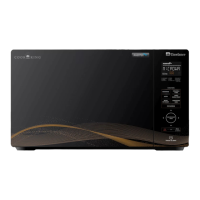5
UTENSILS
CAUTION
Personal Injury Hazard: It is hazardous for anyone other than a compentent person to carry out
any service or repair operation that involves the removal of a cover which gives protection
against exposure to microwave energy.
See the instructions on "Materials you can use in microwave oven or to be avoided in microwave
oven." There may be certain non-metallic utensils that are not safe to use for microwaving. If in
doubt, you can test the utensil in question following the procedure below.
Utensil Test:
1. Fill a microwave-safe container with 1 cup of cold water (250ml) along with the
utensil in question.
2. Cook on maximum power for 1 minute.
3. Carefully feel the utensil. If the empty utensil is warm, do not use it for microwave
cooking.
4. Do not exceed 1 minute cooking time.
Be sure to unplug the appliance from the power supply.
1. Clean the cavity of the oven after using with a slightly damp cloth.
2. Clean the accessories in the usual way in soapy water.
3. The door frame, seal and neighbouring parts must be cleaned carefully with
a damp cloth when they are dirty.
4. Do not use harsh abrasive cleaners or
sharp metal scrapers to clean the oven
door glass since they can scratch the surface, which may result in shattering of
the glass.
5. Cleaning Tip---For easier cleaning of the cavity walls that the food cooked can
touch: Place half a lemon in a bowl, add 300ml (1/2 pint) water and heat on 100%
microwave power for 10 minutes. Wipe the oven clean using a soft, dry cloth.
CLEANING

